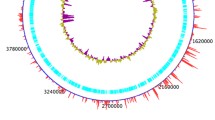Abstract
Pseudomonas aeruginosa causes acute and chronic infections in humans and these infections are difficult to treat due to the bacteria’s high-level of intrinsic and acquired resistance to antibiotics. To address this problem, it is crucial to investigate the molecular mechanisms of antibiotic resistance in this organism. In this study, a P. aeruginosa transposon insertion library of 17000 clones was constructed and screened for altered susceptibility to seven antibiotics. Colonies grown on agar plates containing antibiotics at minimum inhibitory concentrations (MICs) and those unable to grow at 1/2 MIC were collected. The transposon-disrupted genes in 43 confirmed mutants that showed at least a three-fold increase or a two-fold decrease in susceptibility to at least one antibiotic were determined by semi-random PCR and subsequent sequencing analysis. In addition to nine genes known to be associated with antibiotic resistance, including mexI, mexB and mexR, 24 new antibiotic resistance-associated genes were identified, including a fimbrial biogenesis gene pilY1 whose disruption resulted in a 128-fold increase in the MIC of carbenicillin. Twelve of the 43 genes identified were of unknown function. These genes could serve as targets to control or reverse antibiotic resistance in this important human pathogen.
Similar content being viewed by others
References
Gomez M J, Neyfakh A A. Genes involved in intrinsic antibiotic resistance of Acinetobacter baylyi. Antimicrob Agents Chemother, 2006, 50: 3562–3567, 1:CAS:528:DC%2BD28XhtFOkt7rF, 10.1128/AAC.00579-06, 16940057
Holloway B W. Genetic recombination in Pseudomonas aeruginosa. J Gen Microbiol, 1955, 13: 572–581, 1:STN:280:DyaG28%2FjtVKnuw%3D%3D, 13278508
Kulasekara H D, Ventre I, Kulasekara B R, et al. A novel two-component system controls the expression of Pseudomonas aeruginosa fimbrial cup genes. Mol Microbiol, 2005, 55: 368–380, 1:CAS:528:DC%2BD2MXhtVWgt7o%3D, 10.1111/j.1365-2958.2004.04402.x, 15659157
Sambrook J, Fritsch E F, Maniatis T. Molecular Cloning: A Laboratory Manual. Cold Spring Harbor, NY: Cold Spring Harbor Laboratory Press, 1989
Jacobs M A, Alwood A, Thaipisuttikul I, et al. Comprehensive transposon mutant library of Pseudomonas aeruginosa. Proc Natl Acad Sci USA, 2003, 100: 14339–14344, 1:CAS:528:DC%2BD3sXpsFGhsrw%3D, 10.1073/pnas.2036282100, 14617778
Liang H, Li L, Dong Z, et al. The YebC family protein PA0964 negatively regulates the Pseudomonas aeruginosa quinolone signal system and pyocyanin production. J Bacteriol, 2008, 190: 6217–6227, 1:CAS:528:DC%2BD1cXhtFSrs77L, 10.1128/JB.00428-08, 18641136
Stover C K, Pham X Q, Erwin A L, et al. Complete genome sequence of Pseudomonas aeruginosa PAO1, an opportunistic pathogen. Nature, 2000, 406: 959–964, 1:CAS:528:DC%2BD3cXmtlKqsrY%3D, 10.1038/35023079, 10984043
Bohn Y S, Brandes G, Rakhimova E, et al. Multiple roles of Pseudomonas aeruginosa TBCF10839 PilY1 in motility, transport and infection. Mol Microbiol, 2009, 71: 730–747, 1:CAS:528:DC%2BD1MXisFCqtrk%3D, 10.1111/j.1365-2958.2008.06559.x, 19054330
Fajardo A, Martinez-Martin N, Mercadillo M, et al. The neglected intrinsic resistome of bacterial pathogens. PLoS One, 2008, 3: e1619, 10.1371/journal.pone.0001619, 18286176
Dotsch A, Becker T, Pommerenke C, et al. Genomewide identification of genetic determinants of antimicrobial drug resistance in Pseudomonas aeruginosa. Antimicrob Agents Chemother, 2009, 53: 2522–2531, 10.1128/AAC.00035-09, 19332674
Saito K, Eda S, Maseda H, et al. Molecular mechanism of MexR-mediated regulation of MexAB-OprM efflux pump expression in Pseudomonas aeruginosa. FEMS Microbiol Lett, 2001, 195: 23–28, 1:CAS:528:DC%2BD3MXpsFCrug%3D%3D, 11166990
Adewoye L, Sutherland A, Srikumar R, et al. The mexR repressor of the mexAB-oprM multidrug efflux operon in Pseudomonas aeruginosa: characterization of mutations compromising activity. J Bacteriol, 2002, 184: 4308–4312, 1:CAS:528:DC%2BD38XlsVGnt7s%3D, 10.1128/JB.184.15.4308-4312.2002, 12107151
Author information
Authors and Affiliations
Corresponding author
Additional information
Contributed equally to this work
Rights and permissions
About this article
Cite this article
Chen, L., Yang, L., Zhao, X. et al. Identification of Pseudomonas aeruginosa genes associated with antibiotic susceptibility. Sci. China Life Sci. 53, 1247–1251 (2010). https://doi.org/10.1007/s11427-010-4071-8
Received:
Accepted:
Published:
Issue Date:
DOI: https://doi.org/10.1007/s11427-010-4071-8




